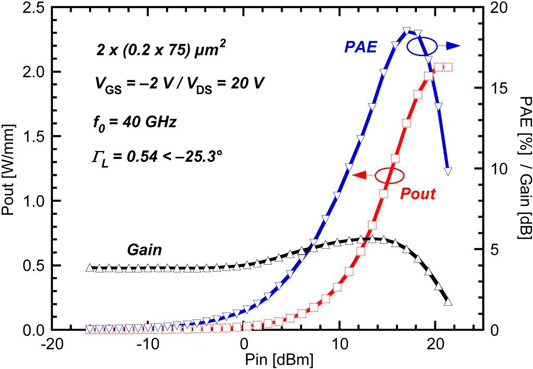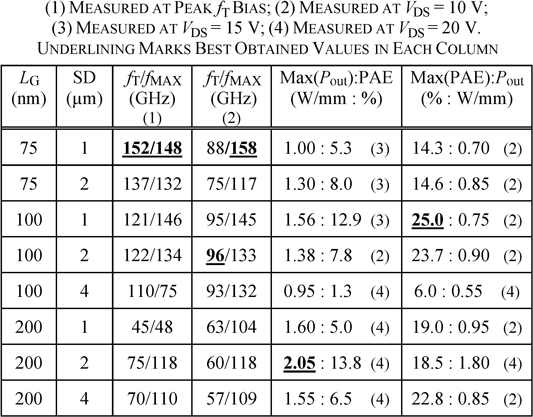Researchers in Switzerland and the USA have reported the first large-signal performance for a gallium nitride on silicon(GaN-on-Si)high-electron-mobility transistors with output power density of 2W/mm and associated peak power-added efficiency(PAE)of 13.8%(peak 18.5%)at 40GHz without field plates[Diego Marti et al,IEEE Electron Device Letters,published online 9 August 2012].The researchers also claim the highest cut-off frequencies to date for fully passivated AlGaN/GaN HEMTs on silicon substrates.
Four of the researchers are with the Millimeter-Wave Electronics Group,ETH Zürich,and one other is with Nitronex Corp,the supplier of the nitride semiconductor on silicon layers.The substrate was 100mm float-zone refined Si(111)that had a high resistivity(10kΩ-cm).The layers consisted of:a nucleation/transition layer,a 1.7μm GaN buffer,a 1nm aluminium nitride(AlN)spacer,a 17.5nm AlGaN barrier,and a 2nm GaN cap.This resulted in a material with improved mobility of 1500cm2/V-s and a crack-free surface.
The transistors were formed with 850°C annealed titanium/aluminum/molybdenum/gold ohmic source-drain contacts,mesa isolation,a recessed nickel/platinum/gold T-gate(200nm high,500nm wide)in the center of the source-drain gap,75nm silicon nitride passivation,and titanium/gold contact pads.
A range of HEMTs were produced(Table 1).For example,a HEMT with a 100nm gate length in a 1μm source-drain gap had a maximum drain current of 1.05A/mm at 2V gate potential and a maximum transconductance of 540mS/mm(for drain bias of 5V and gate potential of-0.5V).The Schottky gate diode leakage was 300μA/mm at-5V gate voltage.The gate-drain breakdown(1mA/mm)occurred at 29V.
Pulsed measurement to assess current-collapse/gate-lag effects showed little dispersion,indicating low-damage impact from the processing despite the deep recessing used.The researchers comment:"The drain lag is moderate and can be attributed to the surface SiN passivation as well as the improved channel confinement associated with the AlN spacer."
Small-and large-signal radio frequency measurements(0.2-40.2GHz)were carried out.The small-signal investigations of a 75nm gate-length device resulted in cut-off frequencies(fT)of 125GHz and maximum oscillation(fmax)of 145GHz before de-embedding.
Making de-embedding corrections at a drain bias of 2.6V and gate bias of-0.5V,using extrapolations of Mason's unilateral gain parameter,gave fT of 152GHz and fmax(U)of 149GHz.The researchers comment:"This fT is the highest value ever reported for any GaN HEMT on silicon,exceeding the previous record established using AlInN/GaN HEMTs,providing a 42%improvement with respect to our previous 75nm AlGaN/GaN-on-Si devices."
The corresponding results for a gate length of 100nm were an fT of 120GHz and fmax(U)of 140GHz(3V drain,-0.4V gate).

Figure 1.Power sweep of 200nm-gate HEMT at 40GHz at bias conditions of?2V gate and 20V drain.The device showed a maximum output power of 2.05 W/mm and a peak PAE of 18.5%.
The frequency performance is also maintained at the drain biases needed for large-signal operation.The devices were tested at 40GHz in a set-up with a nonlinear vector network analyzer(Agilent PNA-X NVNA)source and load-pull.A 200nm gate-length device with 2μm source-drain gap had maximum power output density of 2.05W/mm and corresponding power-added efficiency(PAE)of 13.8%.At a lower power output density of 1.8W/mm the PAE peaked at 18.5%(Figure 1).The gate leakage was 0.3mA/mm during operation.
In general,the longer gates give better large-signal performance(Table 1)."The results confirm GaN-on-Si technology as a promising contender for low-cost millimeter-wave power electronic applications,"the researchers write.

Table 1.Large-and small-signal parameters.
Although better performance can be obtained on much more expensive silicon carbide substrates,there is much interest in GaN-on-Si for wider application in high-frequency high-power electronics.According to the researchers,there have been no reports of large signal for GaN-on-Si beyond 20GHz until now.However,low-noise performance has been reported in recent weeks.





